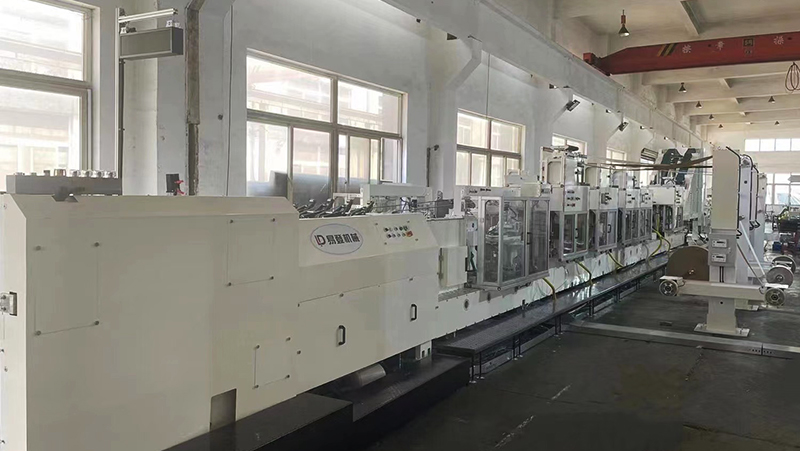Understanding CE Certification for Bag Machines: A Mark of Safety, Compliance, and Market Access
Release time:2025-05-28 Classification:Knowledge
The global marketplace demands not only high-performing equipment but also a demonstrable commitment to safety and regulatory compliance. For manufacturers and purchasers of bag-making machinery, CE certification stands as a critical benchmark. This mark signifies that a bag machine adheres to the stringent health, safety, and environmental protection requirements legislated within the European Economic Area (EEA). Understanding what CE certified entails is essential for navigating international trade and ensuring operational safety.

What Does CE Certification Truly Mean for a Bag Machine?
CE marking is not merely a quality seal; it is a manufacturer's legally binding declaration that their product meets all applicable European Union (EU) directives. For industrial machinery like bag machines, the primary directive is the Machinery Directive 2006/42/EC. Achieving CE certification involves a rigorous process:
- Conformity Assessment: The manufacturer must identify all relevant EU directives and harmonized standards (EN standards) applicable to their specific bag machine type (e.g., flat bag machines, stand-up pouch machines, woven sack machines). Key standards often address safety principles (EN ISO 12100), electrical safety (EN 60204-1), risk assessment, noise emissions (EN ISO 11688), and specific hazards related to moving parts, crushing, shearing, or entanglement.
- Technical Documentation Compilation: A comprehensive technical file must be created. This includes detailed design drawings, risk assessments, lists of applied standards, test reports (e.g., electrical safety, noise levels), calculations, and instructions for safe installation, operation, maintenance, and decommissioning.
- Risk Assessment and Mitigation: A systematic risk assessment is paramount. The manufacturer must identify all potential hazards associated with the bag machine throughout its entire lifecycle and implement appropriate design solutions and protective measures to eliminate or reduce these risks to an acceptable level. This could involve fixed guards, interlocking devices, emergency stop systems (EN ISO 13850), safety light curtains, or inherent safety design principles.
- Internal Production Control (Module A): For most standard machinery, the manufacturer performs the conformity assessment internally. This requires robust internal quality control processes to ensure every unit produced consistently meets the specifications laid out in the technical documentation.
- Involvement of a Notified Body (When Required): Certain higher-risk machines, or those incorporating specific safety components listed in Annex IV of the Machinery Directive (e.g., certain types of logic units for safety functions), necessitate the involvement of an independent, EU-approved Notified Body. The Notified Body examines the technical documentation and may perform audits or specific tests before issuing an EU-Type Examination Certificate.
- Declaration of Conformity (DoC): The manufacturer drafts and signs a formal Declaration of Conformity. This document lists the directives complied with, the applied standards, the manufacturer's details, and often the details of any involved Notified Body. The DoC accompanies the machine.
- Affixing the CE Mark: Only after successfully completing all previous steps can the manufacturer affix the CE certified mark visibly, legibly, and indelibly onto the bag machine, typically on a rating plate or a dedicated nameplate.
The Compelling Benefits of a CE Certified Bag Machine
Investing in or producing a CE certified bag machine offers significant advantages:
- Legal Market Access: CE marking is mandatory for selling bag machines within the EEA and many other countries recognizing the scheme. Without it, customs clearance is impossible, and market entry is blocked.
- Enhanced Safety: The core purpose of CE certification is operator and personnel safety. Compliance reduces the risk of accidents, injuries, and fatalities associated with machinery operation, maintenance, and cleaning. This protects workers and reduces liability.
- Reduced Liability: Manufacturers demonstrating due diligence through the CE process significantly mitigate legal liability risks should an accident occur, provided the machine was used as intended and maintained properly.
- Competitive Advantage: The CE mark signals professionalism, quality, and a commitment to safety standards. It builds trust with potential buyers globally who prioritize compliant and safe equipment.
- Streamlined Procurement: For buyers, specifying a CE certified bag machine simplifies procurement by ensuring the equipment meets baseline EU safety requirements, reducing the need for extensive independent verification.
- Foundation for Global Compliance: The principles embedded in CE certification (risk assessment, safety integration) align with the requirements of many other international markets, providing a solid foundation for achieving compliance elsewhere.
Key Considerations for Buyers and Users
- Verify Authenticity: Ensure the CE mark is affixed correctly and request a copy of the Declaration of Conformity (DoC). Cross-check the manufacturer's details and the listed directives/standards. Be wary of counterfeit marks.
- Understand the Scope: CE certification covers safety primarily. While it implies a certain level of robustness, it is not a guarantee of performance, productivity, or longevity – these remain separate purchase criteria.
- Review Documentation: The instruction manual provided with the CE certified bag machine is a crucial part of compliance. It must contain detailed safety instructions, maintenance procedures, and information on residual risks. Ensure it is comprehensible and in the required language(s).
- Proper Installation and Use: The safety afforded by CE certification relies on correct installation, commissioning, operation, and maintenance as specified by the manufacturer. User training is essential.
CE certification for a bag machine is far more than a regulatory hurdle; it represents a fundamental commitment to safety engineering and responsible manufacturing. For producers, it's a passport to the lucrative European market and a shield against liability. For buyers and operators, it provides assurance that the equipment has been designed and built with rigorous safety standards in mind, minimizing risks in the demanding environment of bag production. When evaluating bag machines, prioritizing CE certified models is a sound investment in compliance, safety, and long-term operational security. Understanding the depth and requirements behind the mark empowers informed decision-making throughout the supply chain.






